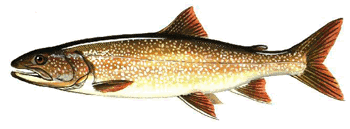Back to Previous Page
LAKE TROUT

At-a-Glance
- Scientific Name: Salvelinus namaycush
- Found in Illinois: Lake Michigan
- State Average:
- State Record: 39 lbs/2.6 oz (2020)
- Best Lures: spoons, flashing lures, minnows
Perhaps the sport fisherman, with his enterprise and ingenuity, will find an effective way of catching this very desirable fish; for they are right now present in substantial numbers in Illinois waters.
Lake trout prefer cold water and are often found at significant depths, though they can be taken in relatively shallow water in spring and fall. For the most part, lakers are caught by trolling anglers using spoons, flashers and flies or cowbells and minnows, often near the bottom.
Trout have a tendency to deteriorate fast after they are caught. Therefore, the angler should immediately remove the gills and internal organs. The quality of the flesh will also be improved by placing the cleaned fish on ice.
Habitat: Before the introduction of salmon and non-native trout into the Great Lakes, lake trout were the top predator. For the past several years, Illinois has stocked lake trout fingerlings in Lake Michigan in cooperation with other states in an overall lake trout rehabilitation program. Traditionally, the lake trout was commercially fished in Lake Michigan; however, it will be sometime before the numbers of these fish will warrant reopening the commercial fishery.
Sea lampreys have severely reduced the lake trout populations. Chemical contaminants and over-fishing pressures have also added to the problem. Increased attention to management and control of the lamprey have helped some lake trout populations to increase.
Feeding and Habits: The establishment of zebra mussels in the Great Lakes and the subsequent water clarity has changed lake trout behavior, and they are now seen feeding further up in the water column. The lake trout feeds primarily on other fish, especially ciscos, alewives. smelt and sculpin.
Reproduction: Lake trout spawn in the fall, depositing their eggs after dark on shoals and rocky reefs. Many lake trout return each fall to use the same spawning location.



